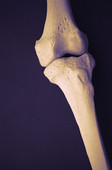
WEDNESDAY, June 17, 2015 (HealthDay News) — Arthroscopic surgery to relieve chronic knee pain in middle-aged and older patients is only temporarily effective and might be harmful, a new analysis suggests.
Researchers who reviewed 18 studies recommended against the procedure as a treatment for arthritis pain or a torn meniscus — the shock-absorbing cartilage between the knee bones — in older adults.
“We found you improve regardless of if you have surgery or nonsurgical treatment,” said one of the researchers, Ewa Roos, a professor in the department of sports science and clinical biomechanics at the University of Southern Denmark.
Dr. David Teuscher, president of the American Academy of Orthopaedic Surgeons, agrees that for this type of knee pain, arthroscopic surgery has no benefit. In fact, doctors in the U.S. no longer use this procedure to relieve knee pain, he said.
“We did the research on this about 15 years ago and realized that arthroscopic surgery for osteoarthritis does not have a long-term therapeutic benefit,” Teuscher said.
The only time it is used is to remove a piece of bone that is floating in the knee joint and restricting function, he said.
For the arthroscopic procedure, surgeons make small cuts in the knee to insert a camera and surgical tools so they can remove or repair damaged tissue, according to the American Academy of Orthopaedic Surgeons. About 700,000 of these minimally invasive procedures are performed in the United States each year on middle-aged and older adults with persistent knee pain, the study authors said.
The analysis showed the procedure was linked to a small amount of pain relief — but not for longer than six months. Moreover, the evidence revealed no significant improvement of physical function.
Also, while complications from knee arthroscopy are rare, some people develop clots in the legs and lungs. “Each year people die following this procedure,” Roos said.
Exercise is a better treatment for chronic knee pain, the study found. “During the last 20 years more than 50 randomized trials have been performed, and there is today strong evidence showing that exercise is effective treatment for knee pain,” Roos said.
The pain relief from exercise is several times greater than from painkillers and from arthroscopic surgery, Roos said.
Patients in pain often need to see a physical therapist to get started, to get a personalized exercise program and to learn how to start exercising with pain, she added.
“Knee pain … will most often subside with time and the number of exercise sessions,” Roos said.
Exercise may even be a better alternative to knee replacement, she said. However, “total knee replacement is a very good treatment when performed at the right time on the right patient,” she said.
The report was published June 16 in the BMJ.
Dr. Andy Carr, a professor of orthopedic surgery at the Oxford University Institute of Musculoskeletal Sciences in England, said trials consistently show that this procedure is no better than a sham operation.
“Supporting or justifying a procedure with the potential for serious harm, even if this is rare, is difficult when that procedure offers patients no more benefit than a placebo,” said Carr, author of an accompanying journal editorial.
For the study, Roos and her colleagues compared the benefits and harms of arthroscopic surgery with other treatments, including placebo surgery and exercise.
Nine of the 18 trials reported only short-term benefits from surgery. The average age of patients in each study ranged from 50 to 63, and follow-up time was three to 24 months.
An additional nine studies on the procedure’s harms found blood clots in the legs (deep vein thrombosis) were the most frequent complication, although rare. Other complications included infection, blood clots in arteries in the lungs (pulmonary embolism) and death.
More information
For more on knee arthroscopic surgery, visit the American Academy of Orthopaedic Surgeons.
Copyright © 2025 HealthDay. All rights reserved.

